Let's talk about MySQL HeatWave in one article
This article brings you relevant knowledge about MySQL, which mainly introduces the relevant content about MySQL HeatWave. MySQL HeatWave is a MySQL cloud service with built-in high-performance memory query accelerator; with the help of this service, we do not need to Any changes to the current application can improve the MySQL performance of mixed workloads by several orders of magnitude; let's take a look at it, I hope it will be helpful to everyone.

#MySQL, as the most popular database in the world, has been dominant in the trading scene for many years. At the end of 2020, OCI (Oracle Cloud Infrastructure) launched a black technology plug-in, which makes up for MySQL's shortcomings in analysis scenarios. Oracle officials claim that it is 1,400 times faster than Aurora, 6.5 times faster than Redshift, and can be divided into two parts. One cost-effective way to do this is MySQL HeatWave.
Introduction to MySQL HeatWave
MySQL HeatWave is a MySQL cloud service with a built-in high-performance in-memory query accelerator. With this service, we can improve MySQL performance for mixed workloads by orders of magnitude without making any changes to our current applications.
Compared with traditional analysis scenarios, MySQL HeatWave eliminates the need for users to use a separate analysis database, separate machine learning (ML) tools, and extract, transform, and load (ETL) replication. Meanwhile, with MySQL HeatWave Machine Learning, developers and data analysts can build, train, deploy, and interpret machine learning models in MySQL HeatWave without having to migrate data to a separate machine learning service.
MySQL HeatWave is currently available on OCI (Oracle Cloud Infrastructure), AWS (Amazon Web Services) and Microsoft Azure.
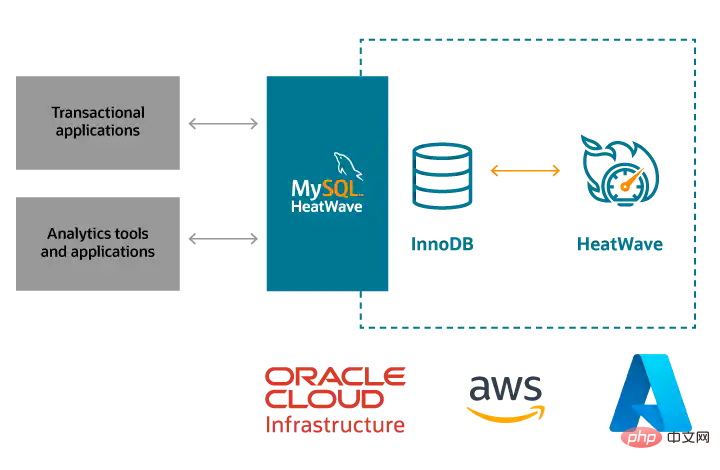
MySQL HeatWave can be attached to MDS (MySQL Database Service) to support analytical queries without being exposed to the application. The database of MySQL HeatWave is stored in memory in the form of column storage.
To simply understand MySQL HeatWave, first understand the following three contents:
Use the same MySQL database to support OLTP and OLAP;
- Data is stored in
memory in a partitioned manner;
- Application
No need to make any changes .
MySQL HeatWave technical architecture
Overall architecture
The architecture of MySQL HeatWave is shown in the figure below , it exists in the entire MySQL database system in the form of a plug-in. It does not directly face the application. It can be understood that MySQL HeatWave is hung under MDS, and users do not need to modify the original data access method. The MySQL HeatWave plug-in corresponds to several MySQL HeatWave Nodes. MySQL HeatWave data is stored in memory as column storage, and its persistent data is stored in object storage, which can be quickly restored after Node failure.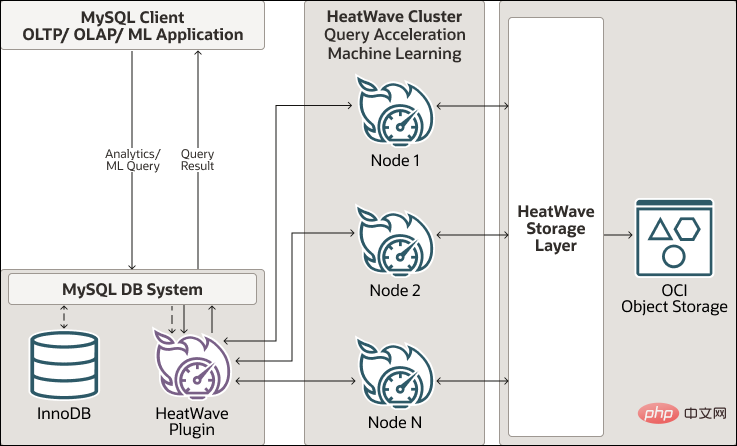
Column Storage
HeatWave data is stored in memory in column storage mode, which facilitates vectorization processing. At the same time, the data will be encoded and compressed before being loaded into the memory, which can improve performance. and reduce memory footprint, thereby reducing costs for customers.
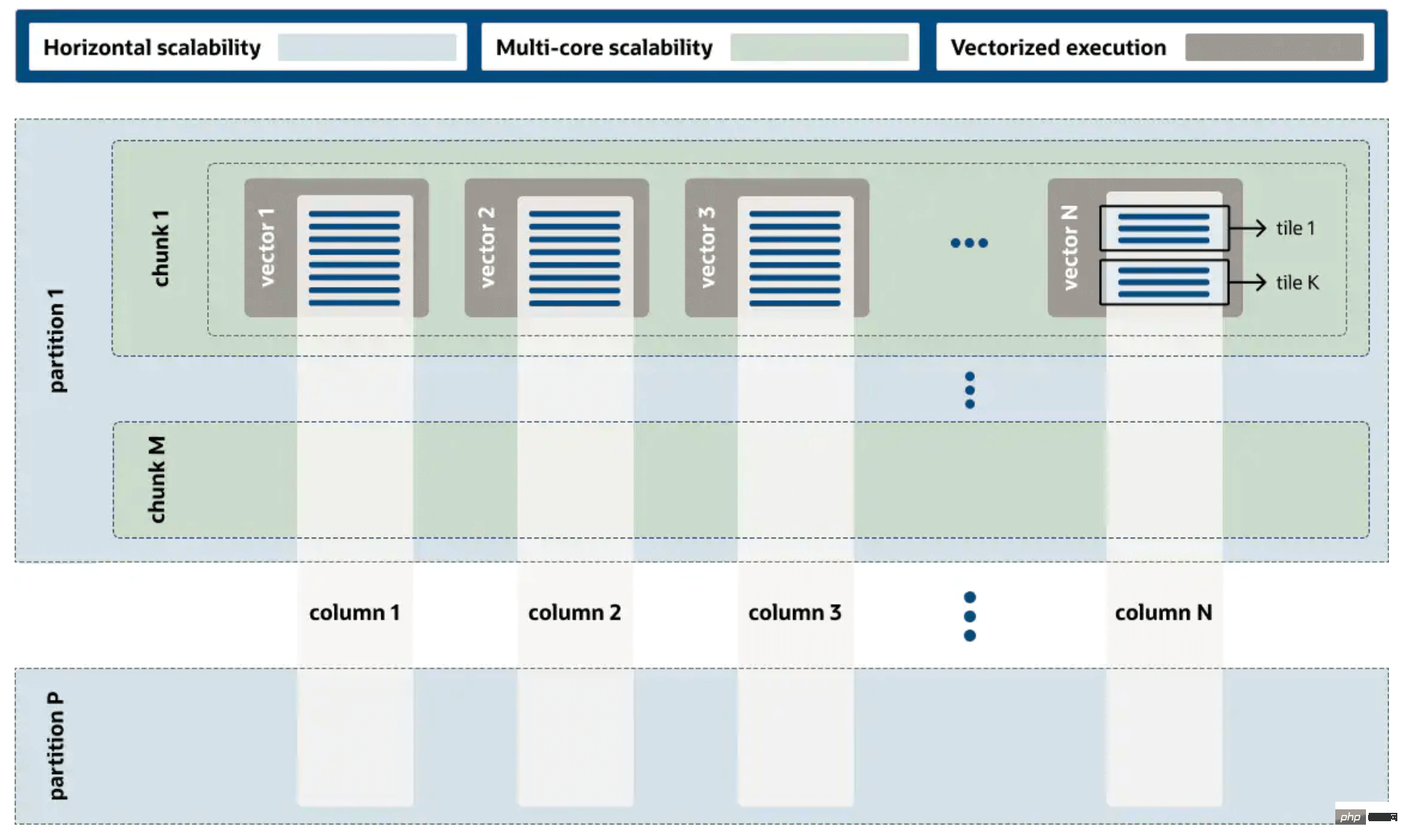
Do horizontal partitioning based on row storage data. Based on horizontal partitioning, queries can be executed in parallel at the node level to speed up scan, join, and group-by. , aggr and top-k operators, while the partition planning is adapted to the underlying RAPID customized hardware.
The data within the partition is organized into columnar storage according to the schema definition to introduce vectorization execution. The unit of each vectorization calculation is a 16KiB vector, and each column corresponds to the vector combination of rows. Together they become chunks, and each partition has multiple chunks.
In order to adapt to DMS, the vector is divided into multiple tiles, and each 64 lines forms a tile as the minimum unit of data transmission.
In order to reduce memory usage, all stored data will be encoded or compressed.
MySQL HeatWave function
The following content is taken from Oracle’s official website at https://www.php.cn/link/4228bfbd579799d63cb20810ef5c04d1
-
A MySQL database meets both the needs of OLTP and OLAP
- No dependence on ETL
- Provides real-time analysis
- Enhanced security
- No need to modify the application
- Supports BI and data visualization tools supported by MySQL database
- Can be used in public clouds and user data centers
-
High-performance in-memory query accelerator
- Designed with large-scale expansion and high-performance architecture
- Optimized for the cloud
- Optimized for high transaction volumes and connections
-
##In-database Machine Learning
- No additional machine learning services required
- Leverage machine learning lifecycle automation to save time and reduce workload
- Interpretable machine learning models
-
MySQL Autopilot
- Automatic Configuration
- Automatic Thread Pool
- Automatic Sharding Prediction
- Automatic coding
- Automatic query plan optimization
- Automatic data placement
- ##MySQL Lake Warehouse Integration (beta)
TPC-H performance is better than similar products
- Quickly analyze all data
- Scalable management and processing data architecture
- Machine Learning drives automatic optimization to improve performance and save time
- Real-time elasticity
Always maintains a stable high level during peak hours Performance, lower costs and no downtime
- Avoid over-provisioning instances
- Fully managed database service
Developed, managed, and supported by the MySQL Engineering team
- MySQL HeatWave Interactive Console: Manage resources, run queries, and monitor performance
- Advanced Security
Asymmetric encryption with key generation and digital signatures
- Data desensitization
- SQL Whitelist
MySQL HeatWave working principle
- RAPID engine supports related functions in statements;
- RAPID engine execution time is estimated to be less than InnoDB's execution time.
After enabling the MySQL HeatWave plug-in, MDS will use two conditions to determine whether the request goes through the RAPID engine for the received request. The engine used by MySQL HeatWave is RAPID. In the development stage, the name of MySQL HeatWave is It's "RAPID".
MySQL HeatWave data loading
Loading method
For MySQL HeatWave data, you can load it in the following three ways:
- Manually load data, loading one table at a time;
- Load data through automatic parallelization, which can be executed in parallel through Autopilot, which is more efficient;
- Passed The console of MySQL HeatWave uses visual operations to complete data loading. This method is currently only available on AWS. Yes, it is true that only AWS supports the MySQL HeatWave console, and AWS is one step ahead of OCI.
The initial data loading may take a while. After completing the data loading, MySQL HeatWave will automatically remain consistent with the InnoDB data. What is worth paying attention to here is that automatically synchronizes changes. The data mode is asynchronous, and users may have to accept a data delay of up to 200ms, which means that data changes on MDS will not wait for feedback from MySQL HeatWave.
Synchronization method
MDS will synchronize data according to the following strategy:
Every 200 ms;
When the change transmission buffer reaches 64MB;
In MDS, when the data changed by DML needs to be read by subsequent HeatWave query.
MySQL HeatWave deployment method
Public cloud
MySQL HeatWave can support OCI (Oracle Cloud Infrastructure), AWS (Amazon Web Services) and Microsoft Azure.
The number of HeatWave nodes required depends on data size, OCI and Azure support up to 64 nodes. On Amazon Web Services (AWS), a HeatWave cluster supports up to 128 nodes.

Hybrid deployment
Hybrid deployment refers to the way of deploying OLTP locally and deploying OLAP in the cloud. In this hybrid deployment, customers You can use MySQL Replication to replicate local MySQL data to OCI or AWS's MySQL HeatWave without the need for ETL to meet analytical business needs.
This hybrid deployment method needs to consider the data delay, which has been introduced in "Data Loading". Data is transmitted asynchronously between InnoDB and HeatWave. In addition to the network delay, it is necessary to Consider the real-time nature of data. It is understood that there is currently no MySQL HeatWave in China.
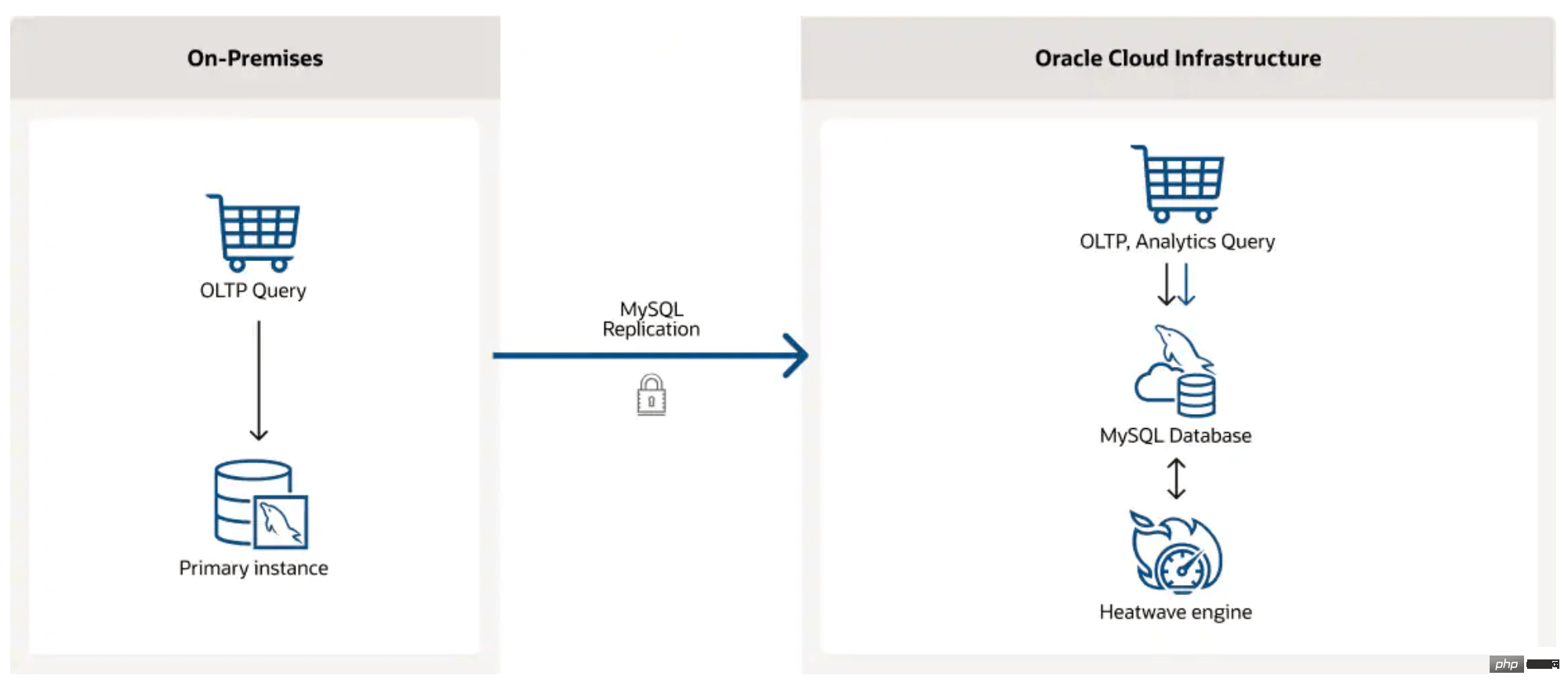
Local deployment
OCI supports deployment in the user's data center, which can meet compliance requirements and allow data to reside in the user's data center of data centers. This kind of deployment method has the following characteristics:
It has an independent OCI cloud area and is hosted by Oracle;
Meets the requirement that data resides in user data The needs of the center;
meet the needs of low latency.
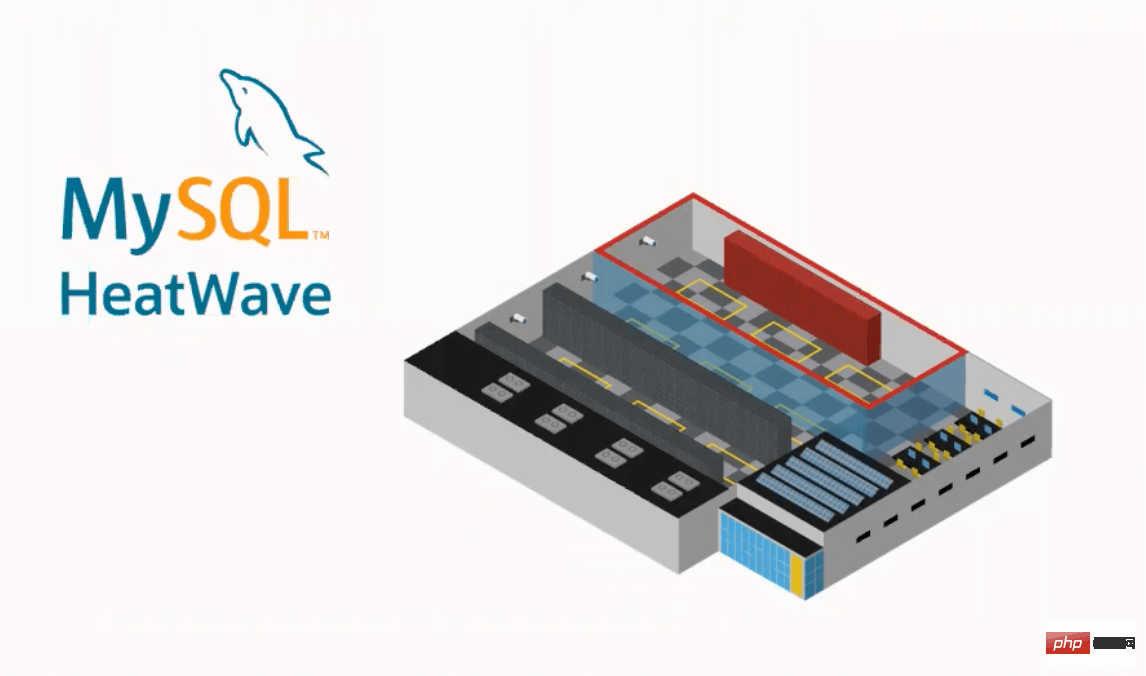
MySQL HeatWave cost-effectiveness
Performance comparison between MySQL HeatWave and Amazon Redshift "fastest instance" , after geometric mean calculation of 19 TPC-H test results, MySQL HeatWave is 2.7 times faster than Amazon Redshift and the cost is only one-third of Amazon Redshift.
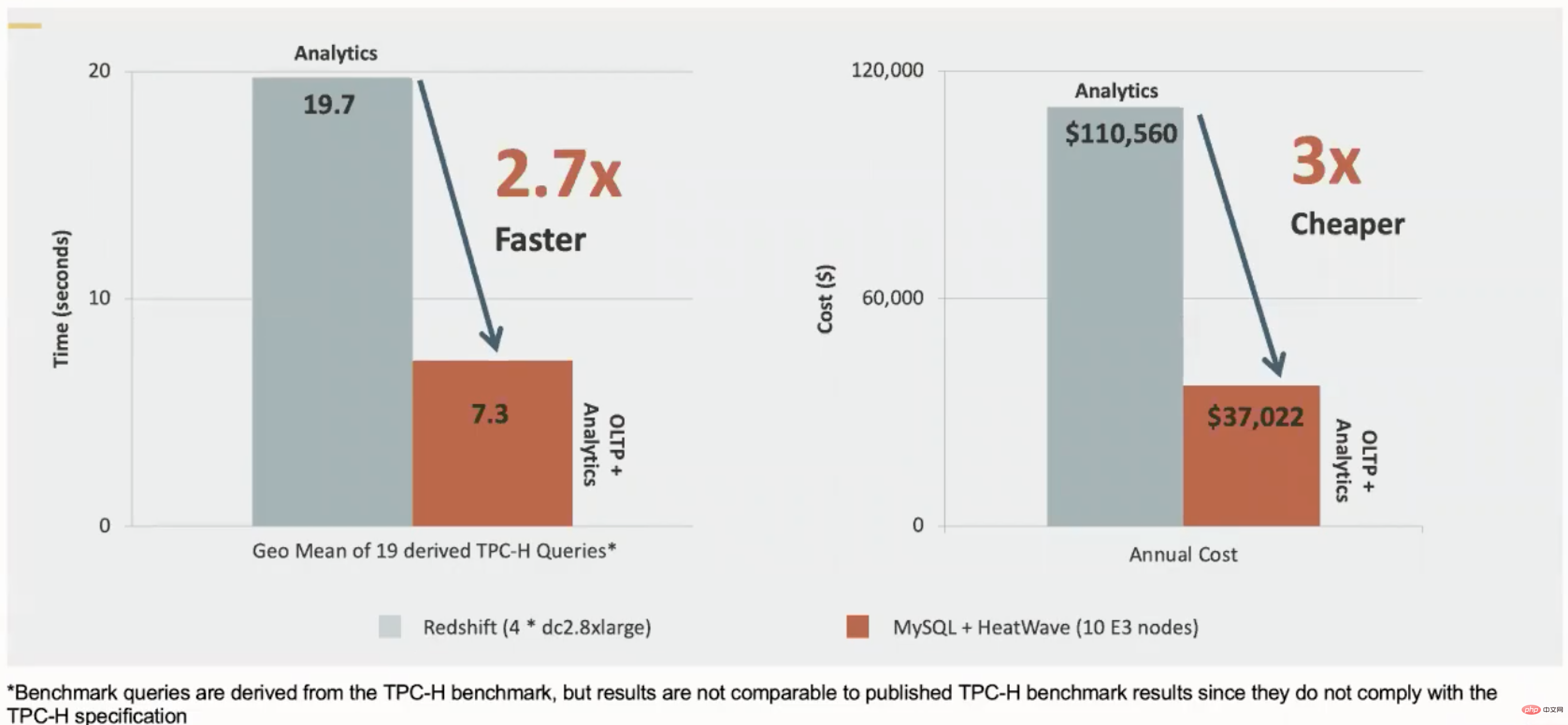
Comparing the performance of MySQL HeatWave and Amazon Redshift "low-cost instances", MySQL HeatWave is more than 17 times ahead of Amazon Redshift in performance, and the investment cost is the same.
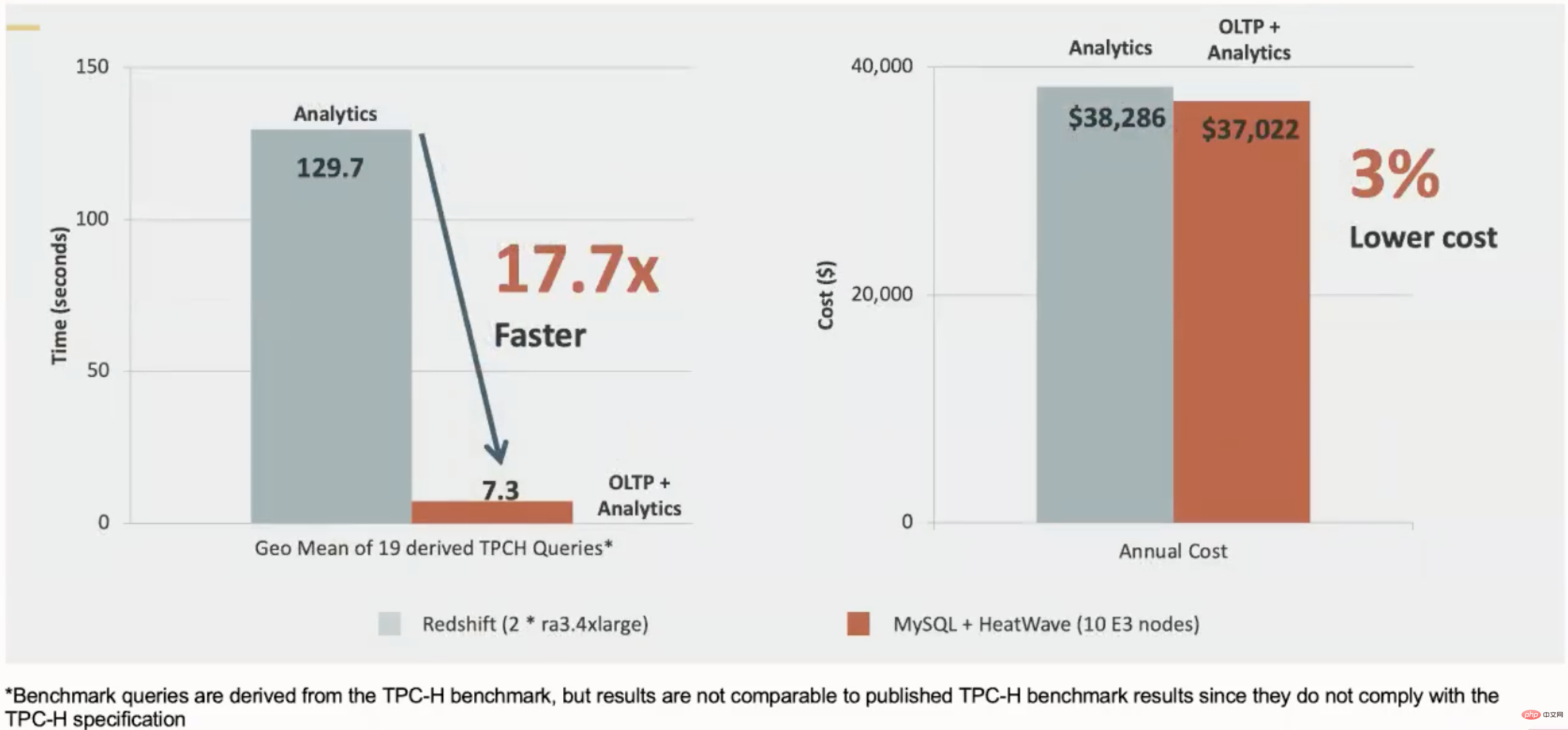
Judging from the official price/performance data, MySQL HeatWave is the most cost-effective compared to several other products in the picture.
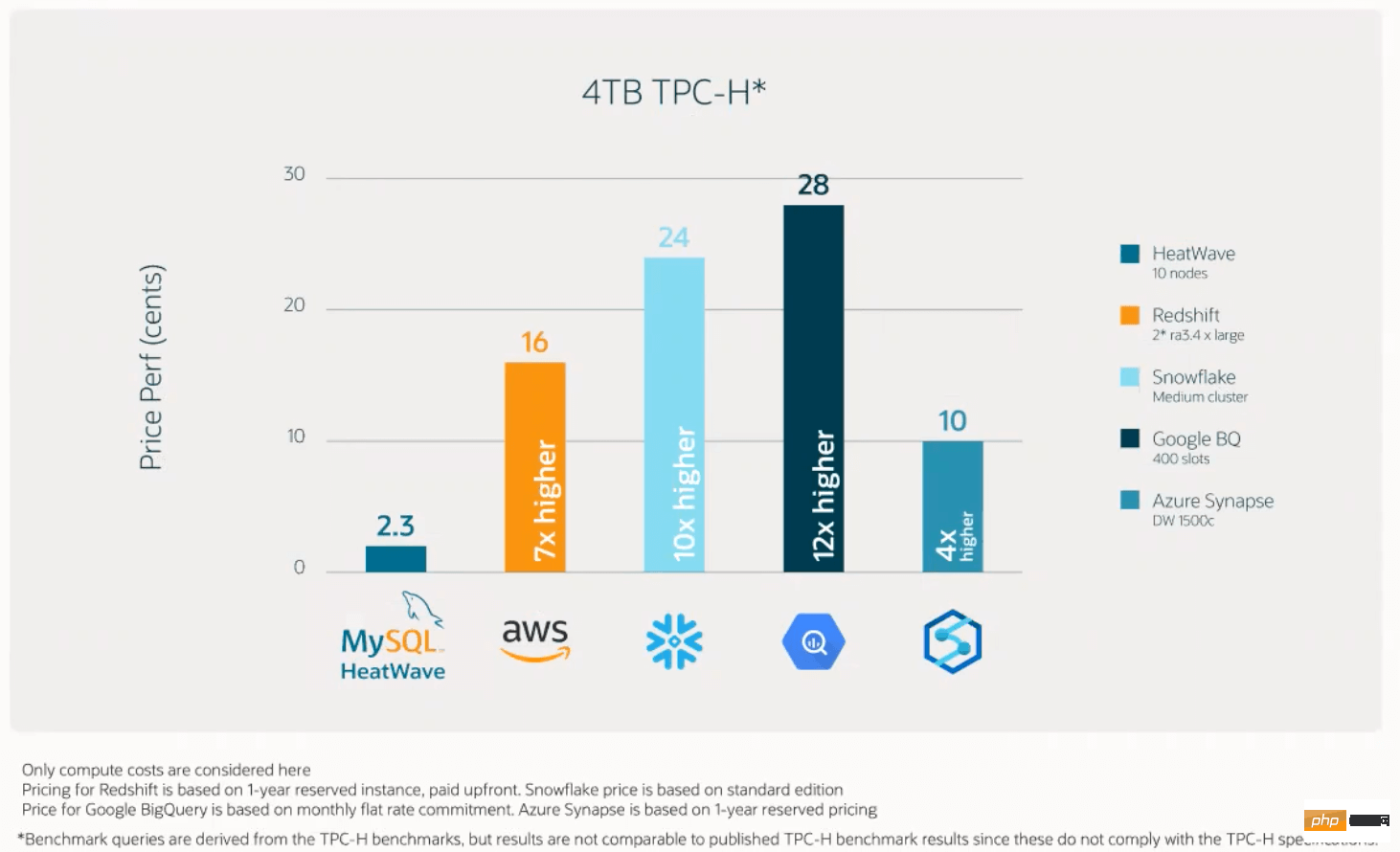
MySQL HeatWave cost
In the Oracle public welfare class, we can learn about the approximate cost of using MySQL HeatWave. For this We only need to pay attention to the lower part of the figure. For an environment with 2T data volume, the monthly cost is approximately US$1,260.
This includes MDS fees, MDS storage fees and HeatWave fees.
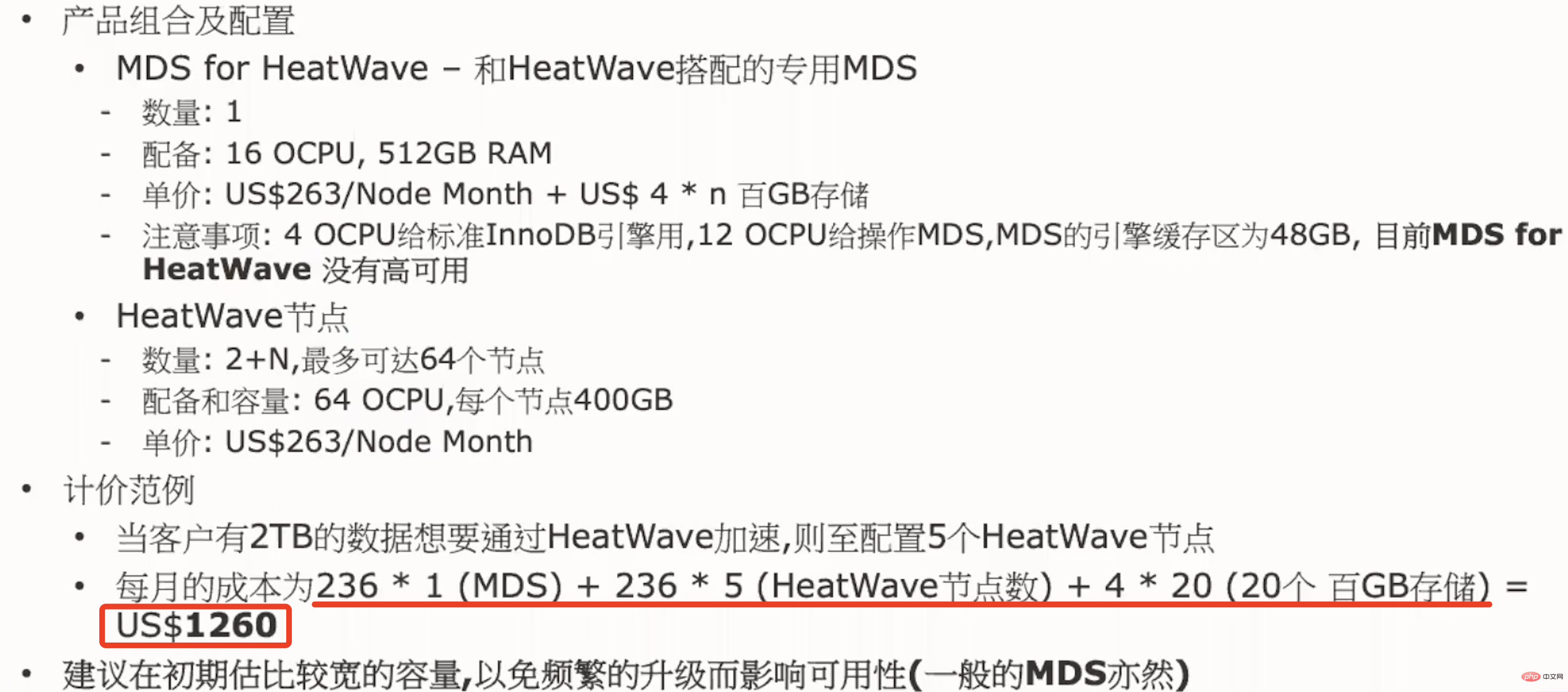
MySQL HeatWave Multi-Cloud Differences
OCI and AWS
HeatWave works better on OCI and The difference between the Roadmaps of the two AWS clouds is quite interesting. As mentioned earlier, visual data loading can only be completed through AWS. Not only this capability, but also from the following figure, AWS is better than OCI in terms of user experience. .
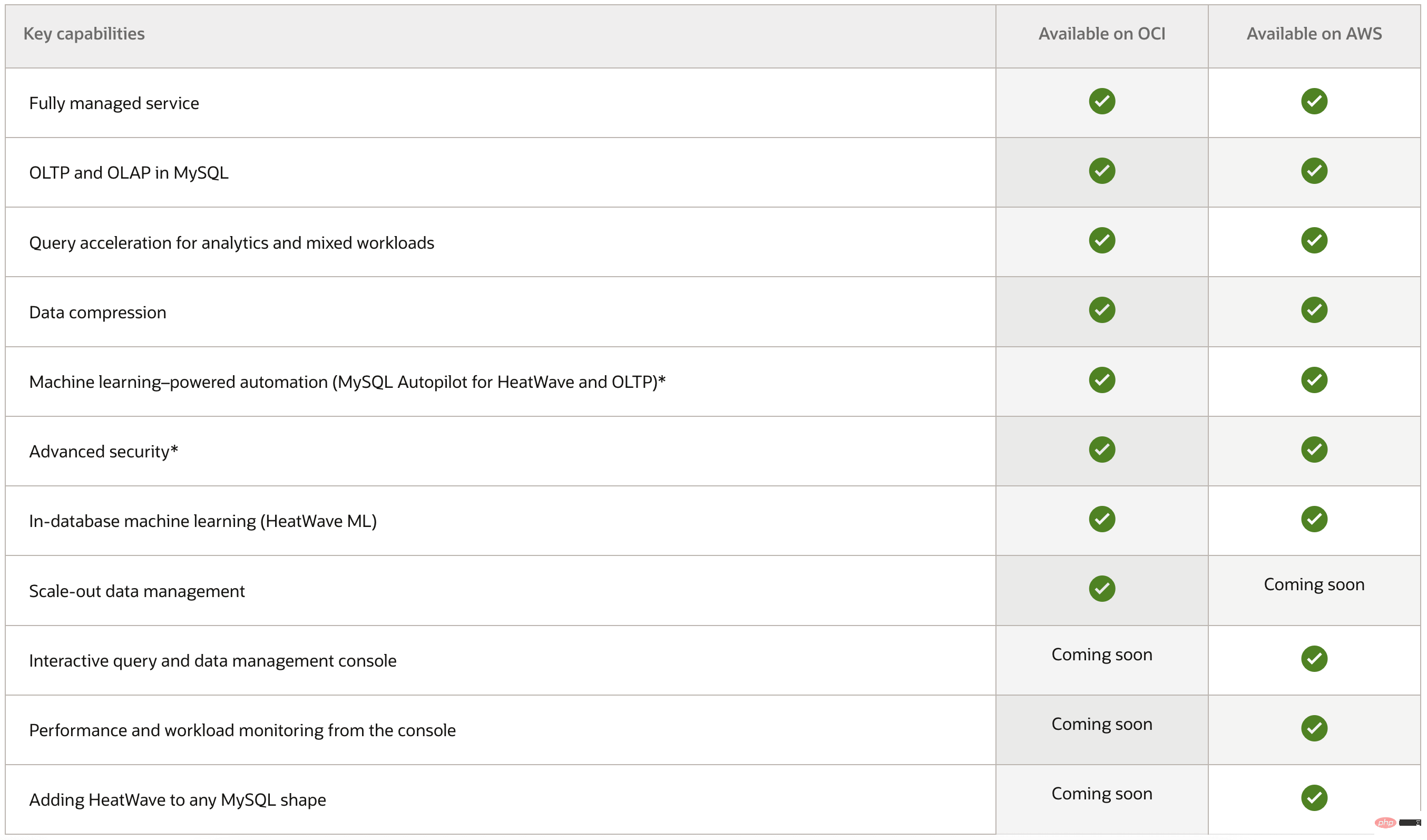
(https://www.oracle.com/mysql/#roadmap)
When you need to use the console in OCI, it will jump to AWS.
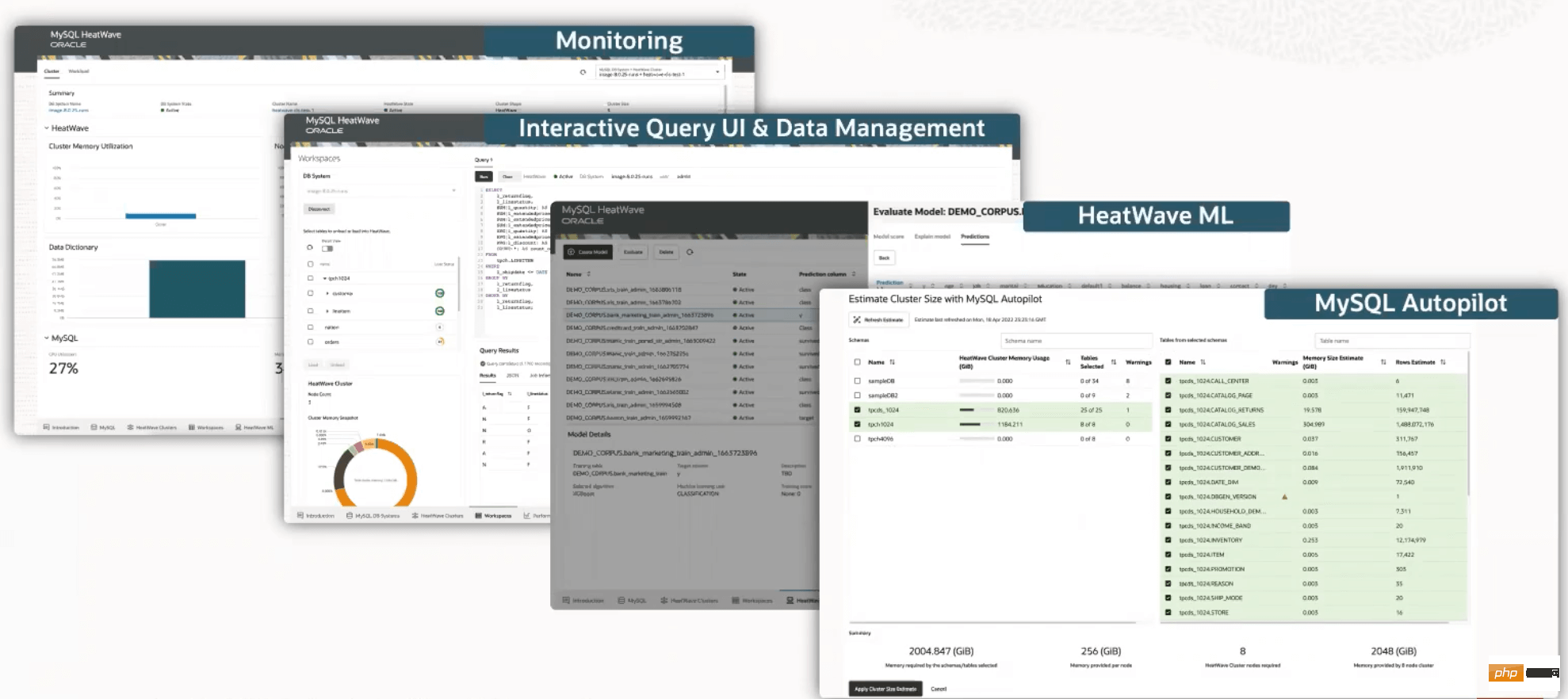
Azure
For Azure users, the MySQL HeatWave service can still be used, which is MySQL HeatWave connected to OCI through Azure VNET. In other words, the OCI environment is actually used.
The purpose is to provide native user experience for Azure users, and the private interconnection method controls the network delay within 2ms.

(https://www.oracle.com/cloud/azure/oracle-database-for-azure/)
Summary
MySQL HeatWave can support use on OCI (Oracle Cloud Infrastructure), AWS (Amazon Web Services) and Microsoft Azure, and also supports the deployment of OCI to user data centers.
After enabling the MySQL HeatWave plug-in, users can use a MySQL service to meet business needs in TP and AP without modifying the business. Data synchronization is automatically completed through internal processes, without the need to maintain ETL separately, and the architecture can be kept simple. The capabilities of autonomous driving (AI) and integrated lake and warehouse give users more expectations.
MySQL HeatWave complements MySQL's ability to analyze scenarios and is of great significance to small and medium-sized enterprises.
There are two deficiencies that deserve users' attention: InnoDB's storage (expansion limitations) and data consistency issues.
Expansion limitations: MySQL HeatWave can provide expansion capabilities, but the storage problem of MySQL InnoDB has not been essentially solved. InnoDB still faces major challenges in the face of massive data.
Data consistency: For scenarios with high data consistency requirements, the delay issue from InnoDB to HeatWave (asynchronous transmission) needs to be considered.
Recommended learning: mysql video tutorial
The above is the detailed content of Let's talk about MySQL HeatWave in one article. For more information, please follow other related articles on the PHP Chinese website!

Hot AI Tools

Undresser.AI Undress
AI-powered app for creating realistic nude photos

AI Clothes Remover
Online AI tool for removing clothes from photos.

Undress AI Tool
Undress images for free

Clothoff.io
AI clothes remover

Video Face Swap
Swap faces in any video effortlessly with our completely free AI face swap tool!

Hot Article

Hot Tools

Notepad++7.3.1
Easy-to-use and free code editor

SublimeText3 Chinese version
Chinese version, very easy to use

Zend Studio 13.0.1
Powerful PHP integrated development environment

Dreamweaver CS6
Visual web development tools

SublimeText3 Mac version
God-level code editing software (SublimeText3)

Hot Topics
 1669
1669
 14
14
 1428
1428
 52
52
 1329
1329
 25
25
 1273
1273
 29
29
 1256
1256
 24
24
 Laravel Introduction Example
Apr 18, 2025 pm 12:45 PM
Laravel Introduction Example
Apr 18, 2025 pm 12:45 PM
Laravel is a PHP framework for easy building of web applications. It provides a range of powerful features including: Installation: Install the Laravel CLI globally with Composer and create applications in the project directory. Routing: Define the relationship between the URL and the handler in routes/web.php. View: Create a view in resources/views to render the application's interface. Database Integration: Provides out-of-the-box integration with databases such as MySQL and uses migration to create and modify tables. Model and Controller: The model represents the database entity and the controller processes HTTP requests.
 MySQL and phpMyAdmin: Core Features and Functions
Apr 22, 2025 am 12:12 AM
MySQL and phpMyAdmin: Core Features and Functions
Apr 22, 2025 am 12:12 AM
MySQL and phpMyAdmin are powerful database management tools. 1) MySQL is used to create databases and tables, and to execute DML and SQL queries. 2) phpMyAdmin provides an intuitive interface for database management, table structure management, data operations and user permission management.
 MySQL vs. Other Programming Languages: A Comparison
Apr 19, 2025 am 12:22 AM
MySQL vs. Other Programming Languages: A Comparison
Apr 19, 2025 am 12:22 AM
Compared with other programming languages, MySQL is mainly used to store and manage data, while other languages such as Python, Java, and C are used for logical processing and application development. MySQL is known for its high performance, scalability and cross-platform support, suitable for data management needs, while other languages have advantages in their respective fields such as data analytics, enterprise applications, and system programming.
 Solve database connection problem: a practical case of using minii/db library
Apr 18, 2025 am 07:09 AM
Solve database connection problem: a practical case of using minii/db library
Apr 18, 2025 am 07:09 AM
I encountered a tricky problem when developing a small application: the need to quickly integrate a lightweight database operation library. After trying multiple libraries, I found that they either have too much functionality or are not very compatible. Eventually, I found minii/db, a simplified version based on Yii2 that solved my problem perfectly.
 Laravel framework installation method
Apr 18, 2025 pm 12:54 PM
Laravel framework installation method
Apr 18, 2025 pm 12:54 PM
Article summary: This article provides detailed step-by-step instructions to guide readers on how to easily install the Laravel framework. Laravel is a powerful PHP framework that speeds up the development process of web applications. This tutorial covers the installation process from system requirements to configuring databases and setting up routing. By following these steps, readers can quickly and efficiently lay a solid foundation for their Laravel project.
 Solve MySQL mode problem: The experience of using the TheliaMySQLModesChecker module
Apr 18, 2025 am 08:42 AM
Solve MySQL mode problem: The experience of using the TheliaMySQLModesChecker module
Apr 18, 2025 am 08:42 AM
When developing an e-commerce website using Thelia, I encountered a tricky problem: MySQL mode is not set properly, causing some features to not function properly. After some exploration, I found a module called TheliaMySQLModesChecker, which is able to automatically fix the MySQL pattern required by Thelia, completely solving my troubles.
 Explain the purpose of foreign keys in MySQL.
Apr 25, 2025 am 12:17 AM
Explain the purpose of foreign keys in MySQL.
Apr 25, 2025 am 12:17 AM
In MySQL, the function of foreign keys is to establish the relationship between tables and ensure the consistency and integrity of the data. Foreign keys maintain the effectiveness of data through reference integrity checks and cascading operations. Pay attention to performance optimization and avoid common errors when using them.
 Compare and contrast MySQL and MariaDB.
Apr 26, 2025 am 12:08 AM
Compare and contrast MySQL and MariaDB.
Apr 26, 2025 am 12:08 AM
The main difference between MySQL and MariaDB is performance, functionality and license: 1. MySQL is developed by Oracle, and MariaDB is its fork. 2. MariaDB may perform better in high load environments. 3.MariaDB provides more storage engines and functions. 4.MySQL adopts a dual license, and MariaDB is completely open source. The existing infrastructure, performance requirements, functional requirements and license costs should be taken into account when choosing.




